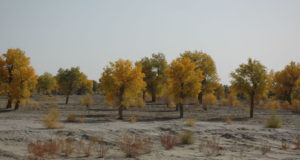
China has invested more resources than any other country in reversing deforestation and planting trees. However, given the large scale of these programs it has been difficult to quantify their impact on forest cover.
A new FTA-related study shows that much of China’s new tree cover consists of sparse, low plantations as opposed to large areas of dense, high tree cover. The results of the study could help policymakers track returns from tree-planting investment and identify suitable environments for future afforestation, aiding efforts to sequester carbon, prevent soil degradation and enhance biodiversity.
China’s forest cover gains are dependent on definition, according to the study, which included FTA scientists.
Since devastating floods in 1998 highlighted the dangers of deforestation, China has enacted strict bans on logging in primary forests, a massive expansion of forest reserves, and multibillion-dollar afforestation programs.
“This approach has undoubtedly had a major impact on reducing loss of trees in China,” said Antje Ahrends of the Royal Botanic Garden Edinburgh (RBGE) and Kunming Institute of Botany (KIB), and lead author of the study. “China has spent more than US$100 billion on planting trees over the last decade alone. However, despite the many successes of this program, planting trees is not the same as gaining forests.”

In China’s fight to halt tree cover loss, Ahrends and her colleagues analyzed high-resolution maps derived from satellite data using different definitions of “forest”. Under the broadest definition, that used by the UN Food and Agriculture Organisation (FAO), China gained 434,000 km² of forest cover between 2000 and 2010 – larger than the areas of Germany, The Netherlands, Belgium and Luxembourg combined.
However, this definition includes scattered, immature or stunted plantations often consisting of a single species or even single clones, which are unlikely to provide the same benefits as large areas of dense and tall forest. The recently published paper was co-authored by a team from organisations including RBGE, KIB and the World Agroforestry Centre (ICRAF).
“We wanted to see how this picture would change if we specifically looked for large areas of tall, relatively dense tree cover” said co-author and FTA scientist Xu Jianchu of ICRAF and KIB. “Understanding the type of cover established by afforestation programmes is critical to understanding the impacts of these projects on soil health, biodiversity and carbon sequestration.”
The results were dramatically different: under the stricter definition, China’s forests expanded by less than a tenth of the previous estimates – 33,000 km², an area smaller than the size of The Netherlands.
The study also noted the practical challenges facing tree planting programmes in China: the country has to feed one-fifth of the global population on less than one-tenth of the world’s agriculturally suitable land, and its growing economy means land suitable for growing trees is increasingly in demand for food production, construction and industrial use.
“Our analysis illustrates the importance of both definitions and large-scale monitoring for understanding changes in tree cover,” said co-author Peter Hollingsworth of RBGE. “It provides enhanced understanding of where tree planting programmes are most successful, and whether those programs are leading to dense forests or sparsely spaced shrubs.”
The report also looks at global trends: the researchers found that roughly half of the world’s forest cover has been lost over the past 10,000 years, and that tree cover is being lost in low-income countries at a rate of around 25,000 km² per year. However, the researchers also found evidence that many countries which have in the past lost much of their forests may be shifting to protect their remaining tree cover.
By Andrew Stevenson, originally published by the World Agroforestry Centre. Edited by Hannah Maddison-Harris.
This research is supported by the Key Research Program of Frontier Sciences of the Chinese Academy of Sciences (grant no. QYZDY-SSW-SMC014). Funding was also provided by the Scottish Government’s Rural and Environment Science and Analytical Services Division (RESAS).
This research forms part of the CGIAR Research Program on Forests, Trees and Agroforestry. We would like to thank all donors who supported this research through their contributions to the CGIAR Fund.











